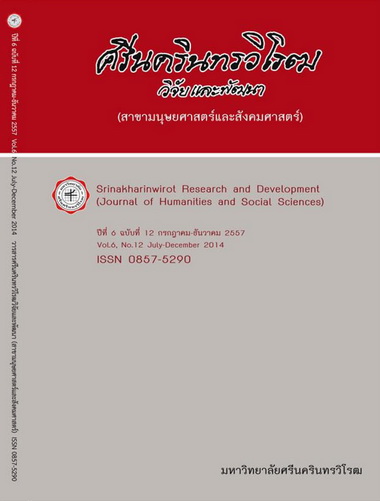แนวทางการพัฒนาคุณภาพโรงเรียนขนาดเล็กในชุมชน (THE APPROACH FOR DEVELOPING THE QUALITY OF SMALL SIZED-SCHOOLS IN THE COMMUNITY)
Keywords:
Approach, Developing, Quality, Small Sized-Schools, CommunityAbstract
บทคัดย่อ การวิจัยเรื่องแนวทางการพัฒนาคุณภาพโรงเรียนขนาดเล็กในชุมชน มีวัตถุประสงค์ 1) เพื่อศึกษาสภาพปัญหาและปัจจัยแห่งความสำเร็จในการบริหารจัดการของโรงเรียนขนาดเล็กในชุมชน 2) เพื่อถอดรูปแบบการบริหารจัดการของโรงเรียนขนาดเล็กในชุมชนที่เป็นต้นแบบ และ 3) เพื่อกำหนดแนวทางการพัฒนาคุณภาพโรงเรียนขนาดเล็กในชุมชม ซึ่งการวิจัยครั้งนี้ได้ใช้กระบวนการวิจัยเชิงปริมาณและเชิงคุณภาพมี 5 ขั้นตอน ได้แก่ 1) ศึกษาวิเคราะห์และสังเคราะห์เอกสารข้อมูล งานวิจัยที่เกี่ยวข้อง 2) สำรวจสภาพปัญหาและปัจจัยแห่งความสำเร็จในการบริหารจัดการของโรงเรียนขนาดเล็กในชุมชน จำนวน 426 แห่ง โดยใช้แบบสอบถามที่มีความเที่ยงตรง (Content Validity) และมีค่าสัมประสิทธิ์แอลฟา 0.96 ซึ่งมีโรงเรียนขนาดเล็กที่ตอบกลับมา จำนวน 295 โรงเรียน คิดเป็นร้อยละ 69.24
จากแบบสอบถามทั้งหมด 3) ศึกษาความคิดเห็นของผู้บริหารโรงเรียนขนาดเล็กที่เป็นต้นแบบเพื่อถอดรูปแบบที่เป็นเลิศสำหรับโรงเรียนขนาดเล็กในชุมชนที่มีการบริหารจัดการของโรงเรียนที่ดี โดยการสัมภาษณ์เชิงลึกกับตัวแทนของโรงเรียนขนาดเล็ก ประกอบด้วย ผู้บริหาร จำนวน 10 คน 4) การตรวจสอบแนวทางการพัฒนาคุณภาพโรงเรียนขนาดเล็กในชุมชน โดยการจัดกลุ่มสนทนาหรือกลุ่มเสวนา (Focus Group Discussion-FGD) กับผู้เชี่ยวชาญด้านการจัดการศึกษาโรงเรียนขนาดเล็ก จำนวน 12 คน และ 5) นำเสนอแนวทางการพัฒนาคุณภาพโรงเรียนขนาดเล็กในชุมชน
ผลการวิจัยพบว่า
1. ผลการศึกษาความคิดเห็นจากแบบสอบถามเกี่ยวกับปัญหา/อุปสรรคและปัจจัยแห่งความสำเร็จในการบริหารจัดของโรงเรียนขนาดเล็กในชุมชน ประกอบด้วย 1) ปัญหา/อุปสรรคส่วนใหญ่ ครูไม่ตรงกับสาขาวิชาเอกหรือวิชาที่ถนัดและครูต้องรับภาระหนักสอนหลายระดับ และหลายรายวิชา จำนวน 231 คน คิดเป็นร้อยละ 78.31 2) ปัจจัยแห่งความสำเร็จ คือ ผู้บริหารมีภาวะผู้นำ จำนวน 281 คน คิดเป็นร้อยละ 95.26
2. ผลการถอดรูปแบบการบริหารจัดการของโรงเรียนขนาดเล็กในชุมชนที่เป็นต้นแบบ พบว่า ผู้บริหารของโรงเรียนขนาดเล็กมีความเห็นว่าสภาพปัญหาของโรงเรียนที่สำคัญ คือ ความเข้าใจเกี่ยวกับการสนับสนุนด้านการศึกษาขององค์การบริหารส่วนจังหวัด/องค์การบริหารส่วนตำบล และครูไม่ครบชั้นและสอนไม่ตรงกับสาขาวิชาที่จบ และตัวบ่งชี้ในการประเมินคุณภาพทางการศึกษาที่มีปัญหาคือ ผลสัมฤทธิ์ทางการเรียนของผู้เรียนเนื่องจากโรงเรียนมีนักเรียนน้อยจึงส่งผลต่อการประเมินคุณภาพโรงเรียน
3. ผู้ทรงคุณวุฒิด้านการจัดการศึกษาโรงเรียนขนาดเล็กเห็นว่าควรเพิ่มในการวิเคราะห์ปัจจัยที่ส่งผลต่อความสำเร็จ การกำหนดแนวทางการวางแผนกำลังคน การสร้างความเข้าใจในบทบาทของคนไทยทุกคนในการสนับสนุนส่งเสริมการศึกษา และการจัดสรรงบประมาณให้เหมาะสมกับความต้องการ
4. แนวทางการพัฒนาคุณภาพโรงเรียนขนาดเล็กในชุมชน ประกอบด้วย 1. ปัจจัยที่ส่งผลต่อความสำเร็จของโรงเรียนขนาดเล็ก ได้แก่ ปัจจัยภายใน ประกอบด้วย 1) ด้านการบริหารจัดการ 2) ด้านบุคลากร 3) ด้านการจัดการเรียนรู้ และ 4) อาคารสถานที่ สื่อ วัสดุ อุปกรณ์ ครุภัณฑ์ และปัจจัยภายนอก ประกอบด้วย 1) การมีส่วนร่วมของชุมชน และ 2) การนำนโยบายสู่การปฏิบัติ และ 2. วิธีการดำเนินงานแบ่งออกเป็น 3 ระดับ ได้แก่ ระดับสำนักงานคณะกรรมการการศึกษาขั้นพื้นฐาน สำนักงานเขตพื้นที่การศึกษา และสถานศึกษา
Abstract
The study of the approach for developing the quality of small-sized schools in the community was aimed to study as follows: 1. to study the problems and success factors of small-sized schools. 2. to capture model of small-sized schools administration in the model community. 3. to define the approach for developing the quality of small-sized schools in the community. This research applied both quantitative and qualitative techniques. The research design was composed of 5 steps as follows: step 1 – to study, analyze and synthesize related documents and research paper, step 2 – to explore the problem and the factors of success of 426 small-sized schools administration in the community through questionnaire with the validity content and reliability was 0.96. In this case, 295 schools (69.24%) from the total number of questionnaires gave the answers, step 3 – to study the opinions of administrators in the model small-sized schools in order to capture the best model of small-sized schools through in-depth interview with the representatives in small-sized schools, these were, 10 administrators, step 4 – to prove the approach of small-sized schools development in the community through focus group discussion with 12 specialists and step 5 – to present the approach for developing the quality of small-sized schools.
The research results were revealed as follows:
1. The results of opinions from the questionnaires in terms of the difficulties/obstacles and success factors of administration in the small-sized schools, these were 1) most problems/obstacles were that the teachers did not meet major or dominant subjects and their teaching loads were in multiple levels and subjects. This was presented from 231 persons and the average was 78.31%. 2) the factors of success were the executive leadership. This was shown from 281 persons and the average was 95.23%.
2. The results of capture management of model small-sized schools in the community was revealed that the principle school problems were the understanding on how to support the education of the Provincial Administration/Organizational Management District and the teachers were not full of class and did not stand in the right major as well as the indicators to assess the quality of education was problematic, it was, the achievement of learners. It was the fact that there were few students, it affected to the quality of the schools.
3. The education experts agreed that small-sized schools should add the factors analysis affecting to the success, the manpower planning, the understanding of the role of Thai people in terms of education support and provide the budget to suit their needs.
4. The approach for developing the quality of small-sized schools was composed of 1. The factors affecting to success of small-sized schools, these were, the internal factors 1) administration 2) staff 3) learning management and 4) building, educational material and media. For the external factors, 1) community participation 2) practical policy and 2.the working process dividing into 3 parts, these were, office level, Office of The Basic Education Commission, Primary Educational Service Area Office and schools.
Downloads
Downloads
Published
How to Cite
Issue
Section
License
Srinakharinwirot Research and Development Journal of Humanities and Social Sciences is licensed Under a Creative Commons Attribution-NonCommercial-NoDerivs 4.0 International (CC-BY-NC-ND 4.0) License, Unless Otherwise Stated. Please Read Journal Policies Page for More Information on Open Access, Copyright and Permissions.



